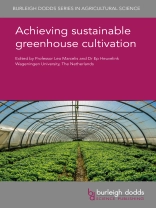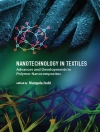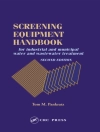- Reviews advantages and disadvantages of different protected cultivation systems, from greenhouses and net houses to aquaponic and vertical farming systems.
- Detailed assessment of current research on optimising the two main variables in protected cultivation: the aerial environment and root development.
- Particular focus on systems control to optimise product quality and environmental impact.
Table of Content
1.Achieving sustainable greenhouse production: present status, recent advances and future developments: Leo F. M. Marcelis, Wageningen University, The Netherlands; Joaquim Miguel Costa, Universidade de Lisboa, Portugal; and Ep Heuvelink, Wageningen University, The Netherlands;
Part 1 Production systems
2.Advances in greenhouse design: Juan I. Montero, formerly Institut de Recerca i Tecnología Agroalimentaries, Spain; and Yi Zhang, Qichang Yang and Xinglin Ke, Institute of Environment and Sustainable Development in Agriculture, China;
3.Advances in screenhouse design and practice for protected cultivation: Josef Tanny, Agricultural Research Organization – Volcani Center, Israel;
4.Sustainable systems for integrated fish and vegetable production: new perspectives on aquaponics: B. W. Alsanius and S. Khalil, Swedish University of Agricultural Sciences (SLU), Sweden; A. Tadesse, Debre Berhan University, Ethiopia; A. K. Rosberg, K. J. Bergstrand, R. Hartmann, L. Mogren, M. Alam, M. Grudén and T. Naznin, Swedish University of Agricultural Sciences (SLU), Sweden; and A. Getahun, Addis Ababa University, Ethiopia;
5.Advances in organic greenhouse cultivation: Martine Dorais, Université Laval, Canada;
6.Towards sustainable plant factories with artificial lighting (PFALs): from greenhouses to vertical farms: Toyoki Kozai, Japan Plant Factory Association, Japan; Yumiko Amagai, Chiba University, Japan; and Eri Hayashi, Japan Plant Factory Association, Japan;
Part 2 Crop management
7.Understanding crop responses to controlled climates in greenhouses: Chieri Kubota, The Ohio State University, USA;
8.Developments in growing substrates for greenhouse cultivation: Youbin Zheng, University of Guelph, Canada;
9.Advances in irrigation management in greenhouse cultivation: Stefania De Pascale, University of Naples Federico II, Italy; Luca Incrocci, University of Pisa, Italy; Daniele Massa, Council for Agricultural Research and Economics, Italy; Youssef Rouphael, University of Naples Federico II, Italy; and Alberto Pardossi, University of Pisa, Italy;
10.Advances in nutrient management in greenhouse cultivation: Neil S. Mattson, Cornell University, USA; and Christopher J. Currey, Iowa State University, USA;
11.Advances in pest and disease management in greenhouse cultivation: Gerben J. Messelink and H. Marjolein Kruidhof, Wageningen University and Research, The Netherlands;
Part 3 System management
12.Automation and robotics in greenhouses: E. J. van Henten, Wageningen University and Research, The Netherlands;
13.Models, sensors and decision support systems in greenhouse cultivation: Oliver Körner, Leibniz Institute of Vegetable and Ornamental Crops (IGZ), Germany;
14.Assessing the impact of environmental factors on the quality of greenhouse produce: Nazim Gruda, University of Bonn, Germany;
15.Sustainable use of energy in greenhouses: S. Hemming, J. C. Bakker, J. B. Campen and F. L. K. Kempkes, Wageningen University and Research, The Netherlands;
16.Assessing the environmental impact of greenhouse cultivation: Assumpció Antón, Erica Montemayor and Nancy Peña, Institute of Agrifood Research and Technology (IRTA), Spain;
About the author
Dr Nazim S. Gruda is Professor of Horticulture at the University of Bonn, Germany. Professor Gruda is internationally-renowned for his research and over 250 publications in areas such as soilless culture, controlled environment cultivation and product quality of horticultural crops. He is Chair of an International Society for Horticultural Science (ISHS) Working Group and has edited Acta Horticulturae for the ISHS. In recognition of his research, Professor Gruda was awarded the 2003 “Dr. Heinrich-Baur-Prize” by the Technical University of Munich, Germany, the 2017 “National Scientific Prize” by the Albanian Academy of Science, and the status of “Distinguished Scientist” by the Chinese Academy of Science in 2020.












